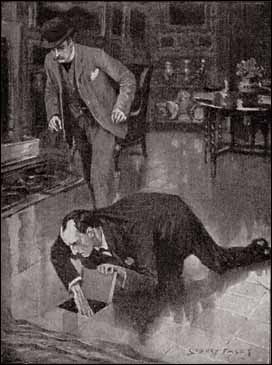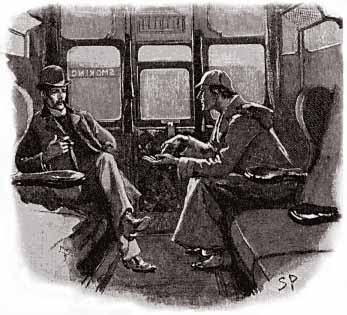“No, no: I never guess. It is a shocking habit—destructive to the logical faculty.” (“The Sign of Four,” Chapter One)
At “A Scintillation of Scions IV” this past Saturday, Vincent Wright, of the Illustrious Clients of Indianapolis, spoke on the subject of the “Initially Seen, But Not Observed.” Specifically, Wright presented on the subject of Alfred Garth Jones, a man whose name was totally unfamiliar to most people in the audience—but whose work was instantly recognizable. Jones was the illustrator of the famous cover of the first hardback edition of The Hound of the Baskervilles, in 1902. It is a book that many Sherlockians own, in some form, or have at least seen many times over. But of those many times, how many readers had given a single thought to the cover art of HOUN, its origins, or its artist? But sometimes all it takes is for one person, like Vincent Wright, to really look at something—the commonplace, the unremarkable, and the routine—and to see the unanswered question lying beneath; to make a logical inference based upon the knowledge of some bit of information—no matter how elusive that information may be—without leaping ahead while there are still gaps in information. Some of Sherlock Holmes’s most striking deductions came by looking at nothing, but observing the absence of something crucial, rather than seeing only a dearth of clues.
The Sherlock Holmes story, “Silver Blaze,” contains one of the Great Detective’s most famous and oft-quoted deductions. Having learned all he can from the stables at King’s Pyland, Holmes and company are preparing to move on to the next location. When asked if he has observed anything crucial, Holmes merely remarks cryptically that he would like to draw their attention:
“To the curious incident of the dog in the night-time.”
“The dog did nothing in the night-time.”
“That was the curious incident,” remarked Sherlock Holmes.
What Holmes is referring to, of course, is that fact that the guard dog did not bark when the intruder entered the stable to steal the racehorse, Silver Blaze. The absence of this activity indicated that whoever had come in must have been familiar to the canine, and did not arouse suspicion. The villain, John Straker, was the lead trainer and someone who was seen every day around the stables, and the dog would have felt no fear of him, and thus no need to bark. Rather than looking at a silent guard dog and seeing no clue, Sherlock Holmes observed an absent behavior, which in and of itself turned out to be one of the case’s most crucial clues. In another instance, Holmes would rely upon the absence of a conclusion in one mystery, in order to find the correct solution to another.
One of the more interesting features of “The Six Napoleons” is the fact that Holmes had already worked the case once before. As he tells Lestrade and Watson, “You will remember, Lestrade, the sensation caused by the disappearance of this valuable jewel, and the vain efforts of the London police to recover it. I was myself consulted upon the case, but I was unable to throw any light upon it.” If Sherlock Holmes seems to be positively blasé about this supposedly less than successful investigation, it is not because he has finally brought the case to an end. It is not to say that he previously worked the case without success, but instead that he worked the case without conclusion. However, Sherlock Holmes being Sherlock Holmes, the Detective knew that the absence of a solution in one instance did not preclude the existence of one entirely.
Holmes refers to his detective work in SIXN as “a connected chain of inductive reasoning,” and Inspector Lestrade calls the case “workmanlike.” They are both correct, of course, but the item of note is that observing a missing element was a crucial step in the deductive process. Marking the missing conclusion from his previous case, Sherlock Holmes knew that a satisfactory solution—and by association, the missing pearl of the Borgias—must exist somewhere. Simply labeling a case without a solution as unsolvable would not do, and regarding an elusive object as lost forever—simply for the crime of being elusive—would not stand either.
 |
| Not pictured: The "I'm not following this" expression on Lestrade's and Watson's faces. |
In “The Second Stain,” upon opening his despatch-box to find the missing diplomatic letter safely within its depths, Trelawney Hope exclaims, “Thank you! Thank you! What a weight from my heart. But this is inconceivable–impossible. Mr. Holmes, you are a wizard, a sorcerer! How did you know it was there?” To which Sherlock Holmes replies, “Because I knew it was nowhere else.”
This statement, of course, is not precisely true. Holmes is, in fact, shielding Hope’s wife, who is the one who had initially stolen, and then secreted away the important document. Holmes did not know the letter was in the despatch-box—in fact, the Detective placed it there himself to complete his ruse—but he did know that Lady Hope was in possession of the letter, simply because there was nowhere else it could be. Following his train of deductions, Sherlock Holmes finds himself at the home of the murdered spy, Eduardo Lucas. Sending Inspector Lestrade out the room, Holmes immediately begins to search for what he knows must be present:
 “He tore the drugget from the floor, and in an instant was down on his hands and knees clawing at each of the squares of wood beneath it. One turned sideways as he dug his nails into the edge of it. It hinged back like the lid of a box. A small black cavity opened beneath it. Holmes plunged his eager hand into it and drew it out with a bitter snarl of anger and disappointment. It was empty.”
“He tore the drugget from the floor, and in an instant was down on his hands and knees clawing at each of the squares of wood beneath it. One turned sideways as he dug his nails into the edge of it. It hinged back like the lid of a box. A small black cavity opened beneath it. Holmes plunged his eager hand into it and drew it out with a bitter snarl of anger and disappointment. It was empty.”Empty. But what of the Great Detective’s deductions, his logical inferences? Although he is for a moment stymied, it does not take Holmes long to realize that the absence of the document from the place he imagined it to be—the place he knew it to be—was the key indicator in another solution entirely.
Remarking on the absence of activity or behavior is not the same as a guess. A guess indicates a lack of knowledge and the need to move ahead without some crucial piece of information. With a lucky jump, a guess can sometimes get one over the gaps in the deductive bridge, but can just as easily leave you plunging into the abyss of blunder and falsehoods. In SILV, SIXN, and SECO, what Sherlock Holmes is doing is observing nothing, and discovering the various ways in which the nothing is itself, a clue. As Holmes says in SILV: “See the value of imagination…It is the one quality which Gregory lacks. We imagined what might have happened, acted upon the supposition, and find ourselves justified. Let us proceed.”
oOo
“A Scintillation of Scions” is an annual Sherlockian event in Columbia, Md., hosted by “Watson’s Tin Box.” Learn more about the group here.
“Better Holmes & Gardens” now has its own Facebook page. Join by “Liking” the page here, and receive all the latest updates, news, and Sherlockian tidbits.



A beautiful post, woven with care. I love the themes you choose to explore, and this one is particularly fruitful, it seems. Noticing what is "not there" is certainly one of Holmes' peculiar gifts. I am also delighted with the connection you made to the cover art and artist of HOUN. Thanks for presenting that cover and leading me to take a close look--not that I would pass over such a beautiful cover!
ReplyDeleteI'm also happy to see your new FB page for Better Holmes & Gardens!
Wonderful post! Thanks for giving "nothing" a star turn as a clue. Other mystery writers, such as Georgette Heyer, have used the "no clues" technique in their stories, but of course no one does it better than Conan Doyle and Holmes.
ReplyDeletewww.joliebeaumont.weebly.com
@Lucy: Thank you so much for your wonderful comment! Sometimes my thoughts seem to get away from me when I get on a theme I'm particularly enthusiastic about, so I'm pleased to hear that this post was cohesive. And the original cover of HOUN was remarkably lovely. It was very fun to hear the collective gasp of realization as Vincent Wright revealed it to the audience!
ReplyDelete@Jolie: Thank you for reading and thank you for your kind comment! I'm not as familiar with Georgette Heyer's works as I probably should be, and you've inspired me to begin them anew. Thank you again!